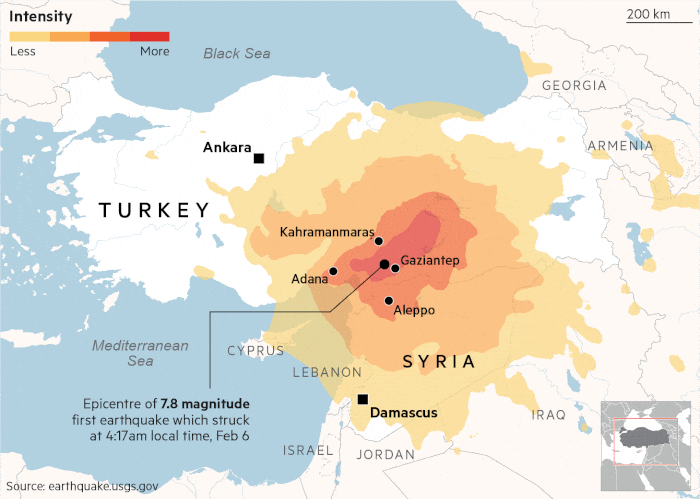Lana Abdel-Hamid had just enough time to gather the younger members of her family and escape her home in the Syrian city of Aleppo before the minaret of the neighbouring mosque collapsed on top of the building.
“God saved me and my children. When the shaking started, I grabbed them and ran outside,” said the 26-year-old mother of two. “But we still haven’t found my father. I’m scared for night to come before we’ve found him and our neighbours and I’m worried for another earthquake.”
Such desperate scenes were replicated across northern Syria and south-eastern Turkey, where authorities were on Monday racing to contain a deepening humanitarian crisis after the region was rocked by its worst earthquake in eight decades.
The initial quake, with a magnitude of 7.8, and a series of strong shocks that followed caused devastation in towns and cities in south-eastern Turkey and over the border in northern Syria, killing more than 2,400 people and leaving many more injured. The death toll is expected to rise significantly.
The first, most devastating quake, struck near the Turkish city of Gaziantep in the early hours, setting off shockwaves that could be felt as far away as Egypt and Israel. A second quake hit about 60 miles away several hours later, with dozens of smaller tremors also shaking the region, felling thousands of buildings and sending people running out into the streets for safety.

Residents in several Turkish provinces fled their homes in near-freezing temperatures, into the rain and snow, according to witnesses. Video footage showed rescue workers digging through rubble; on one street in Gaziantep, an apartment building collapsed even as rescuers worked nearby.
Residents roamed the streets calling for help as they surveyed the ruins of their cities. One man in Elbistan, a town close to the epicentre, videoed flattened buildings in disbelief, crying out: “This was our main high street. We are without hope.” A castle that has stood sentinel over Gaziantep for hundreds of years suffered significant damage, underscoring the historic level of power exerted by the quake.
Rescuers were able to pull a child out of the rubble of a collapsed apartment block in Adana province, while earthmoving equipment cleared mangled steel and concrete in Diyarbakır as rescue workers called out to try and contact any survivors. The desperate search continued as darkness fell on Monday night. Rescue workers at some scenes called for silence to hear potential victims under the rubble.

In Adana province, one social worker who declined to give their name witnessed scenes of desperation and panic. “I ran here when the earthquake first happened. When I first came to the debris, I heard the sound of people screaming out for help.”
Many of Adana’s residents recalled the deadly quake that struck the city in 1998. “This is bigger than that, definitely bigger,” said Gül Turnali, a housewife.
Turkey’s Red Crescent humanitarian agency said it had sent mobile kitchens, more than 1,000 tents and almost 20,000 blankets to the area. Islamic Relief, another aid organisation, said it had launched a $20mn fundraising campaign, warning that its supply of mattresses, blankets and other bedding would probably run out within hours. Turkey, which has called for international help, has received offers of aid from a host of countries including the US, UK, Netherlands and Azerbaijan.

Syrian state television showed footage of rescue teams searching for survivors in stormy weather, with health officials asking the public to help rescue their neighbours and take them to hospitals. A video published by the Syrian American Medical Society, which supports medical facilities in the north-west of the country, showed a chaotic emergency room at the Bab Al Hawa hospital in Aleppo “overflowing with cases”.
“Our hospitals are overwhelmed with patients filling the hallways,” the group said, adding that several of its hospitals had sustained “severe damage” including Idlib Hospital, from where newborns were evacuated to a nearby facility that was still operating.

The affected area of north-west Syria is one devastated by 12 years of war that wiped out much of the area’s infrastructure. It is also one of the last remaining pockets held by what remains of Syria’s splintered opposition, which could complicate rescue efforts.
Heavy rain and snowfalls were making access to the damaged areas more difficult, with “hundreds of families” still trapped under the rubble, the Syrian Civil Defense, also known as the White Helmets, said in a statement.
“So many buildings were destroyed and I saw tens of people under the rubble, with crowds trying to pull them out,” said Mohammed Hamza, head of Islamic Relief’s office in Idlib, north-west Syria. “People are still out in the streets — they don’t have anything to go home to and we are all scared of aftershocks.”
Many of those in the affected region had already been displaced from elsewhere in the country by conflict. As such, many live in informal settlements on the outskirts of cities, in open fields and in abandoned buildings. Much of the area’s medical infrastructure was also destroyed during the war as hospitals were routinely targeted in air strikes.
Turkish authorities said on Monday evening that 1,651 people had been killed and more than 8,500 injured in the country. Some 430 people were confirmed dead in government-controlled areas of Syria and more than 380 were killed in the north-western region controlled by the opposition.


























































![Mason Ramsey – Twang [Official Music Video] Mason Ramsey – Twang [Official Music Video]](https://i.ytimg.com/vi/xwe8F_AhLY0/maxresdefault.jpg)





















